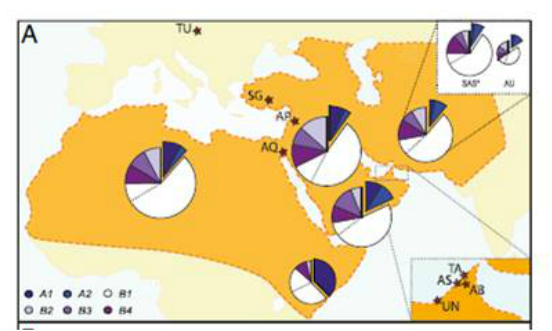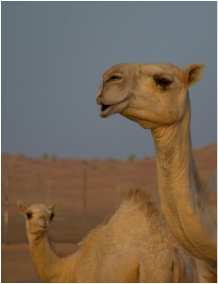Biology
Ancient and modern DNA analysis reveal dynamics of
domestication and dispersal of the Arabian Camel
|
The dromedary (Camelus dromedarius) or Arabian camel has enabled transportation of people and valuable goods over long distances connecting Arabia, the Near East and North Africa. They have been critical in the development of human societies in this geographic region for 3000 years and today remain invaluable in arid and marginal environments supporting millions of people. Advancing desertification and global climate change predictions for the MENA region have prompted interest in the biology and production traits of the species and we now have available the first annotated genome drafts. In an article by Almathen et al. published in PNAS, the history of camel domestication and the influence of ancient trading networks on their genetic structure were studied applying genomic and phylogenic analyses using 759 current mitochondrial and 15 ancient DNA material. Results show how important long-distance and back-and-forth movements in ancient caravan routes shaped the species’ genetic diversity and suggest a history of restocking from wild animals from the southeast coast of the Arabian Peninsula. The study concludes: ‘A remarkable feature in the history of dromedary domestication is the substantial genetic diversity of the domestic population, given the temporally and geographically restricted coexistence of early-domestic animals and their wild ancestors, which already were heading to extinction when the domestic form emerged. Modern dromedary populations largely maintained and consolidated this ancestral diversity, often lost in other livestock, underlining their potential to adapt sustainably to future challenges of desertification and climate change.’ |
2016
|
|
Fig.1 Representation of regional differences in mitochondrial DNA retrieved from modern camels and archaeological specimens. PNAS 2016 113: 6707-6712. doi: 10.1073/pnas.1519508113
Reference:
Faisal Almathen, Pauline Charruau, Elmira Mohandesan, Joram M. Mwacharo, Pablo Orozco-terWengel, Daniel Pitt, Abdussamad M. Abdussamad, Margarethe Uerpmann, Hans-Peter Uerpmann, Bea De Cupere, Peter Magee, Majed A. Alnaqeeb, Bashir Salim, Abdul Raziq, Tadelle Dessie, Omer M. Abdelhadi, Mohammad H. Banabazi, Marzook Al-Eknah, Chris Walzer, Bernard Faye, Michael Hofreiter, Joris Peters, Olivier Hanotte, and Pamela A. Burger. Ancient and modern DNA reveal dynamics of domestication and cross-continental dispersal of the dromedary PNAS 2016 113: 6707-6712. doi: 10.1073/pnas.1519508113 You may also want to read : Fitak, R. R., Mohandesan, E., Corander, J. and Burger, P. A. (2016), The de novo genome assembly and annotation of a female domestic dromedary of North African origin. Mol Ecol Resour, 16: 314–324. doi:10.1111/1755-0998.12443 Article Rights
PNAS figure1 Almathen et al. 2016 Ancient and modern DNA reveal dynamics of domestication and cross-continental dispersal of the dromedary. PNAS 2016 113: 6707-6712. |

